Experience and training are the foundation of our work. Although experience may vary a great deal, training in the fire service remains fairly consistent. Hands-on tactics, size-up skills, and firefighting procedures are thoroughly presented in our training academies and analyzed in procedural manuals. “Imagination” seldom appears in any of the written training material. Yet, it is the incident commander’s (IC’s) imagination that can often make the difference between an operation that goes very well and one that doesn’t.
- Revisiting Incident Action Plans and the Incident Management System
- Qualities of Effective Incident Commanders
- Fireground Commander’s Intent: Coordinated Actions for Mission Success
The most uncomfortable position when managing a fire is playing “catch up.” If the number of personnel is insufficient, if the fire is more extensive than anticipated, or if exposures suddenly become a major concern, the fireground’s challenges and the danger can grow geometrically. Using your imagination is vital in your ability to see beyond the obvious, to plan for that worst-case scenario if it occurs, and to prepare for the unexpected events that may pop up.
A lack of imagination has been cited as a contributing factor in past tragedies. Both the 9/11 Commission report and the National Aeronautics and Space Administration’s review of the space shuttle Challenger disaster specifically mention the need to use imagination to prevent future catastrophes. Admiral James Stavridis, a 30-year veteran of the United States Navy and the former supreme allied commander of the North Atlantic Treaty Organization (NATO), mentions the role of imagination in To Risk It All: “By thinking through contingencies in advance, it is possible to better predict crisis scenarios and thus provide greater decision making flexibility for leaders in a moment of crisis. It engenders a mental discipline for people who go into difficult situations, forcing them to think through how to react in different scenarios. It removes the most powerful constraint on those making hard choices: a lack of imagination.”
Firefighters, company officers, and chiefs are most definitely individuals who routinely face difficult situations and are required to make rapid decisions in moments of crisis. The following examples show that imagination can be a tool in helping to make hard choices and maintain flexibility in fireground decision making.
Basement Backdraft
Heavy fire in a commercial occupancy (photo 1) presents several immediate concerns for an IC. Water supply, additional aid, personnel accountability, and apparatus positioning all must be addressed. However, it is vital to consider not only where the operation is now but also what might possibly happen over the next few minutes, even if it seems that progress is being made in extinguishing the fire. In this nighttime scenario, the interior attack was suspended and outside streams were applied to the building. The tire store occupancy contained a huge fire load on the first floor and in the basement. Even after the initial fire was knocked down, the basement retained an enormous amount of heat and flammable gases—ideal conditions for a possible backdraft and exactly what happened approximately 10 minutes after this photo was taken.
Fortunately, envisioning this possibility allowed us to prepare for it. We withdrew personnel to a safe distance from the building and repositioned apparatus. When the backdraft occurred, no one was injured. The fire was safely extinguished after an all-night operation. It took some imagination to envision and prepare for an “unexpected” event.
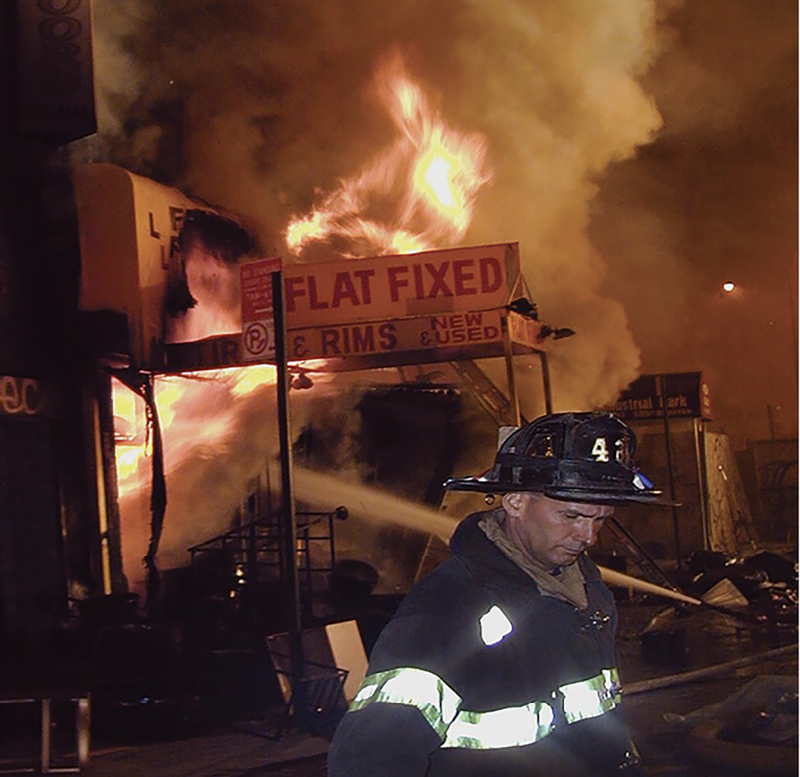
(1) Photo by Steve Spak.
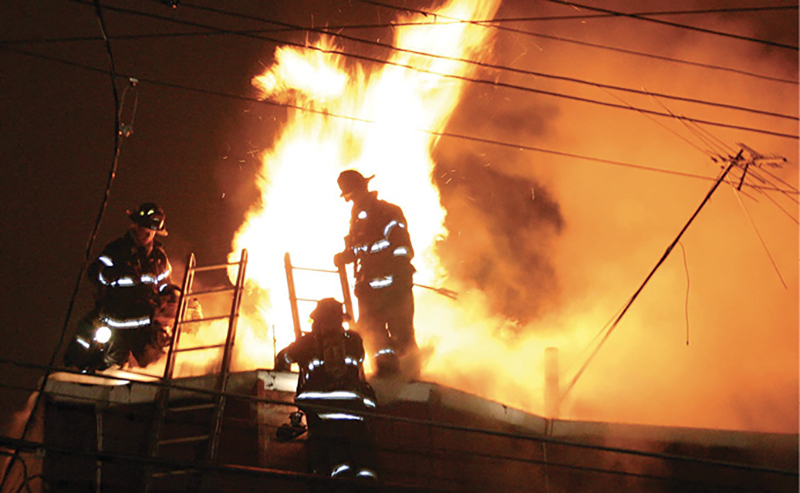
(2) Photo by Chris Creighton.
Side Wall Collapse
If not rapidly contained, a fire in a wood-frame building (photo 2) has deadly potential. Here, time is of the essence since the structure consists of flammable wooden components with little or no fire resistance. An IC must remain aware of his inner “ticking clock” and realize when it is time to change strategy. If not enough progress is being made, it’s time for his imagination to kick in. The building is weakening every minute that it burns. A risk analysis would dictate that at some point the IC must consider removing his personnel and transitioning to an outside operation. Sometimes you must order this transition despite the protests of inside personnel who feel that they may be making progress in extinguishing the fire.
In this case, the transition to a different strategy was accomplished very smoothly. The image of a potential side wall collapse was utmost in my mind even in the early stages of the firefight. It was the worst-case scenario; the load-bearing floor joists most often run parallel to the front of the structure and place most of the building load directly on the side walls. A weakened side wall can lead to a catastrophic collapse. In this operation, the side wall did eventually fail (photo 3) but only after all personnel had been ordered out of the building.
Anticipate and Act
At times, it’s easy to feel somewhat overwhelmed when managing a major fire (photo 4). Command and control of numerous firefighters who are performing a variety of tactics at the same time can tax even the most experienced ICs. However, regardless of the volume of fire or the presence of numerous distractions, you need to maintain that space in your mind that allows you to see beyond what is immediately obvious. In photo 4, there is more to consider than the large body of fire. Previous experience has shown that this type of structure has components that over time are particularly vulnerable to collapse (photo 5). You must take necessary precautions, even if it the operation appears to be going well and fire is being extinguished. Imagining a collapse allows you to tap into your training and consider what collapse zones and apparatus repositioning might be needed.
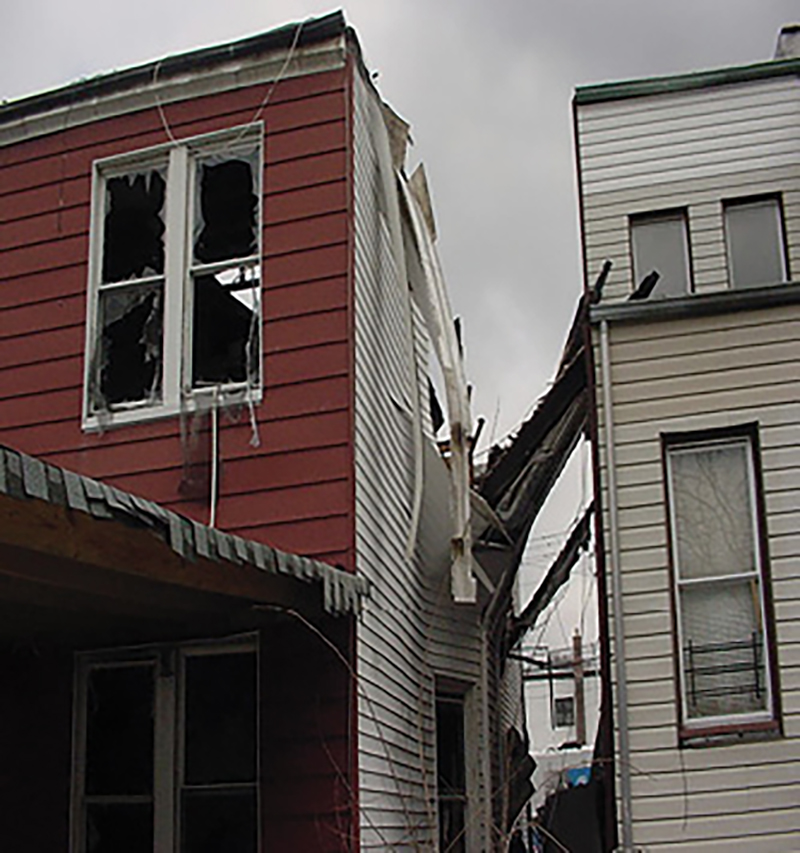
(3) Photo by author.

(4) Photo by Bill Tompkins.
Renovated Buildings
You can also put imagination to use in performing hands-on tactical work. An experienced firefighter assigned to overhaul an older commercial occupancy will know that the building may have been extensively renovated. Immediately apparent features can readily hide other structural elements or conceal pockets of fire. The dropped ceiling hanging above you that seems so easy to open up may be only the most recent of several previously installed ceilings (photo 6). Pause for a moment to envision what lies above before starting the work; it will enable you to assemble the required tools, assign sufficient personnel, and position a hoseline if you uncover an area of fire.
One of the best ways to prepare for a safe firefighting operation is to learn as much as possible about the buildings in your response area before any incident occurs. It’s a great habit to get into, observing the buildings as you routinely move about your neighborhood. Again, the ability to envision what kinds of scenarios you might face under emergency conditions will prime you for an actual event. What occupancies seem to have the greatest life hazard or exposure risks? Which ones have structural hazards or possible water supply issues? Running such questions through your mind will make you that much more prepared to establish a quick, effective firefighting strategy if you are suddenly thrust into the challenge and stress of an actual fire.
Life Hazards
An initial look at the exposure A side of this building (photo 7) might indicate a strategy of placing the first hoseline into the particular store that happened to be burning. A closer look at the structure’s rear indicates that the most severe life hazard might well be the private dwelling on the C side (photo 8). Such observations are easier to make in daylight than at night. Similarly, the clear view offered in photo 9 allows you to consider building hazards, exposure considerations, and fire wall locations, all very useful information if you ever have to work on that structure’s roof. It’s far better to plant that knowledge in your mind during the ease of a prefire inspection than under the fog of heavy smoke and the noise of operating roof saws.
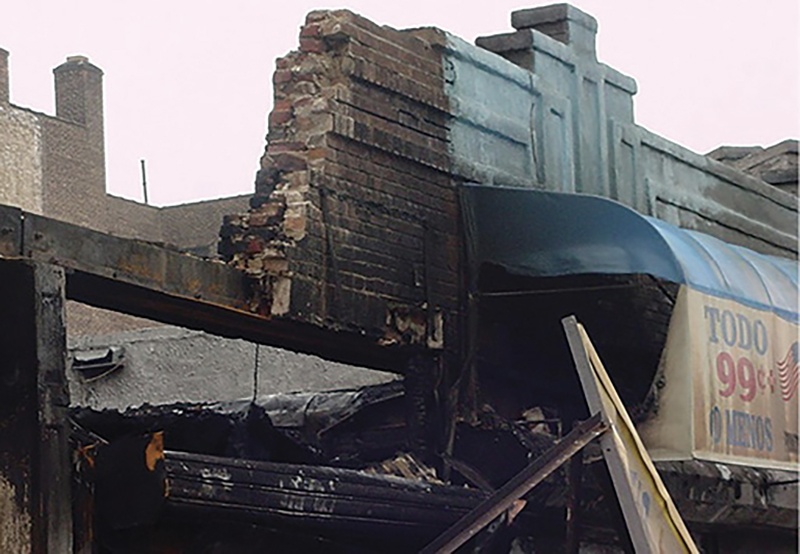
(5-9) Photos by author.
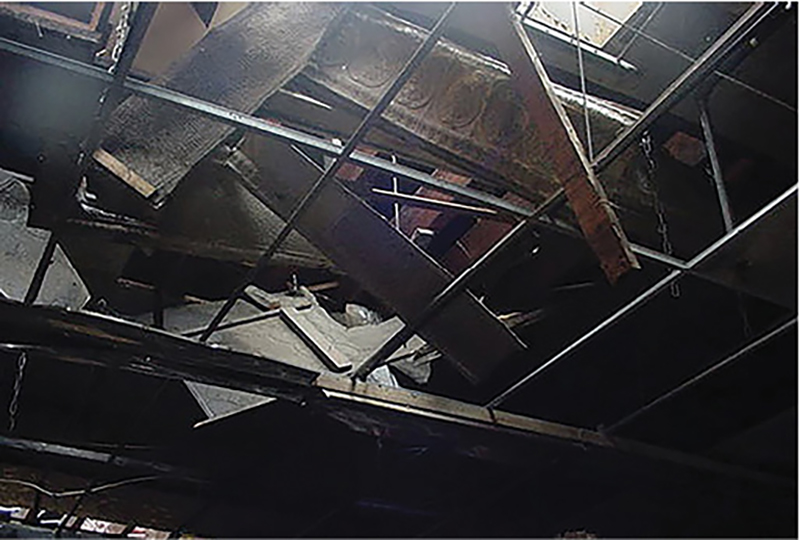
(6)

(7)

(8)

(9)
Evaluate Your Thinking
You can’t disconnect your fireground strategy from the facts. Building construction, fire volume, availability of resources, and numerous other elements all lead toward establishing your initial plan of action. However, it is vital to periodically take a step back and perform an honest mental “progress report” of where exactly you stand at different points in the operation. Are you making the progress you should be making at this point in the firefight? If not, it may be time to reevaluate your approach and imagine other possibilities. Perhaps there are unknown factors at play in the operation that will call for a different strategy.
A 2020 Harvard Business Review article intended to guide businesses in dealing with the COVID-19 pandemic has several recommendations that apply to the fire service as follows:
- Ask active questions. We do this in the size-up of a fire or emergency response.
- Seek out the unexpected. Will the initial water supply be adequate? What unknown building construction details or aspects of the fire could suddenly create unforeseen hazards?
- Encourage experimentation. Although our procedures have evolved from decades of fireground experience, unfortunately, at times, they have also been modified as a result of firefighter injuries and fatalities. There is something to be said for being receptive to new ways of doing things. Transitional fire attack as a practical fireground strategy was once dismissed by some; now, it is part of standard operating procedures in many departments.
- Set up a system for sharing ideas. Using your imagination should not be restricted to a few leaders. An organizational culture that encourages members to develop it at all levels will enable growth. Observation and networking are the keys to accomplishing this. Mentors, coworkers, and leaders are all in a position to teach and influence others by their example each time they demonstrate an ability to visualize and adapt to unforeseen problems on the fireground.
Refining Your Imagination
Everyone maintains a certain level of imagination. However, everyday distractions, repetitive work routines, and even certain aspects of our education can inhibit our ability to use it. Just as we train for the other, more tangible firefighting aspects, we should also learn to develop our imaginative capabilities.
The Power of Stories and Simulations
Everyone likes a good story; listening to stories is one way that we learn. When we follow a story line, it activates a portion of our brains in a manner that doesn’t occur when we listen to a lecture or read a book that is fact driven and data oriented. Reading or hearing a story about someone who is involved in performing an activity affects your cortex, and you mentally participate and live in that story. This is called grounded cognition, highlighted in an Emory University study. Participants were assigned to read an interesting novel prior to having MRI brain scans. The results indicated that the participants showed a “muscle memory” of the novel’s story line even though they were not reading it while undergoing the MRI. They concluded that a captivating story can actually have a biological effect on your brain and make you more receptive to feeling as though you were part of that story.
We use versions of storytelling in the fire service when we train personnel. There are a lot of stories bouncing around firehouse kitchens, most of them relating to that unique blend of humor, sports, and politics so favored by many firefighters. However, many of the stories are about firefighting incidents that firefighters have witnessed. The narrator is creating a picture of his experience as he relates the story. The audience is living out that experience in their minds. They can imagine how the fire went, picture the smoke and fire conditions, and consider the problems that arose and how they were overcome. As the story is told, it reinforces lessons informally; listeners exercise a component of their minds that will prove useful when they face a similar firefighting challenge in the future.
In a similar way, using computerized fire simulations can encourage mental flexibility in firefighting strategy. These simulations can present a variety of buildings along with special effects that portray changing fire and smoke conditions, enabling the programs to project a realistic view of a variety of scenarios that are, in effect, a series of fire stories. A key component here is the trainer’s ability to select different outcomes for the exercise and to introduce unanticipated elements over the course of the drill. Even though it all occurs in a classroom environment, the thought patterns experienced in the simulation can be transferred to performance at an actual fireground situation.
These are effective means of drawing in people to the lessons being reinforced and, since they are story oriented and not fact/data driven, they encourage grounded cognition and the use of imagination. However, most fire training material consists of factual training manuals. This is required because of the enormous amount of technical information that a firefighter must retain to safely perform his job. Our strategies must be based on facts, but does constant exposure to this written material and factual knowledge needed to learn the job and then to compete in promotional exams limit our ability to think outside the box? Rigid adherence to factual information may create a mindset that inhibits our willingness to use imagination to reevaluate fireground situations, envision unexpected problems, and consider alternate strategies.
Throw Some Curveballs in Your Training
Training sessions are most productive when they create a level of stress and uncertainty. Drills that tightly adhere to a scripted scenario with a predicted outcome will often merely reinforce knowledge and abilities that are already in place. To help develop an outlook that leaves room for growth, it is best to include some unknown factors and to introduce elements that may not normally be expected. Initiate a Mayday transmission in the middle of a search drill or a loss of water in a tabletop exercise. First-due units may not always get to the scene because of an accident or heavy traffic conditions. There may be reports of fire suddenly appearing in areas that were thought to be secure. By creating an evolving training scenario with ongoing problems, you create an environment for the participants that forces them to react and consider what other potential issues may be awaiting them. They will have to go beyond just evaluating what is apparent and consider what other possibilities may be ahead.
The science of firefighting involves sizing up a situation and managing the necessary resources to confine and extinguish the fire. The art of firefighting calls for a mindset that not only addresses the immediate needs but also considers the unexpected problems that always seem to surface. Your imagination is a powerful tool in accomplishing this. To quote Albert Einstein, “Logic will get you from A to B. Imagination will take you everywhere.”
References
Stavridis, James. (2022) To Risk it All. Penguin Press.
Kean, Thomas and Hamilton, Lee. (2004) The 9/11 Report. St Martin’s Press.
National Aeronautics and Space Administration. (January 27, 2014) Apollo 1- Challenger-Columbia Lessons Learned. https://go.nasa.gov/3TzMPEL.
Daniels, I. David. Imagination as a Safety Tool. (October 23, 2020) Safety+Health. https://bit.ly/3UYC14j.
Reeves, Martin, and Fuller, Jack. (April 10, 2020) We Need Imagination Now More Than Ever. Harvard Business Review. https://bit.ly/3tu96t3.
A Novel Look at How Stories May Change the Brain (December 17, 2013) eScienceCommons, Emory University. https://bit.ly/3UBWUT3.
Dunne, Thomas. (2020) Notes from the Fireground. McFarland & Company.
Thomas Dunne is a retired deputy chief and a 33-year veteran of the Fire Department of New York (FDNY) with extensive experience working in midtown Manhattan and the Bronx. He has written numerous articles for Fire Engineering and lectures on a variety of fire service topics. He is the author of the FDNY memoir Notes from the Fireground and the soon to be released novel A Moment in Time.

